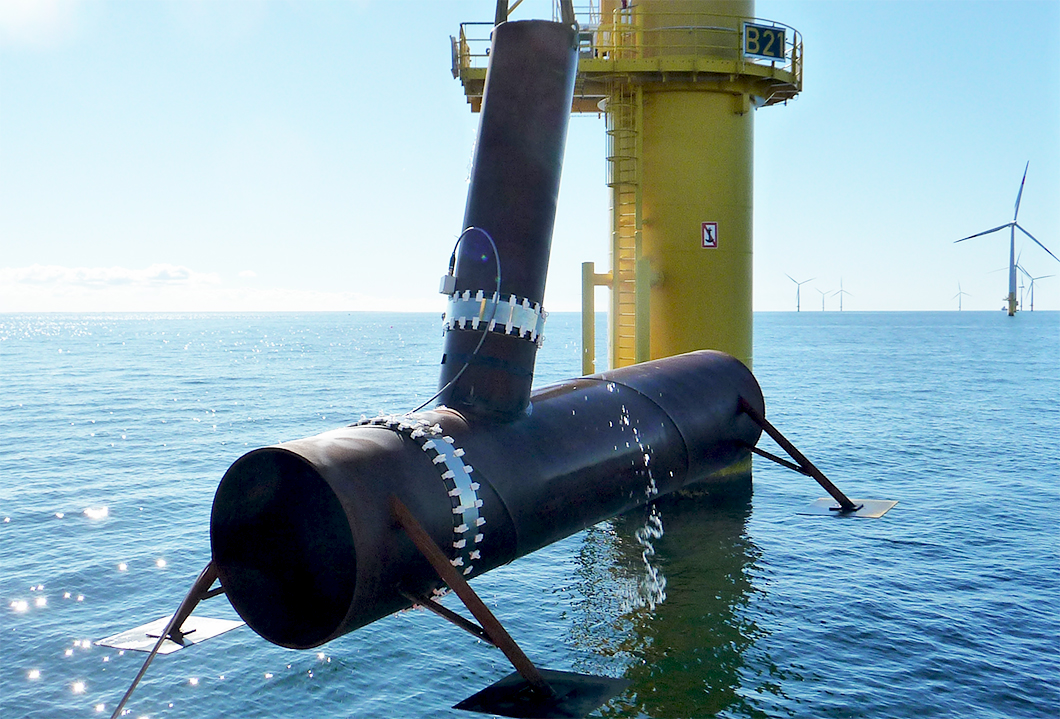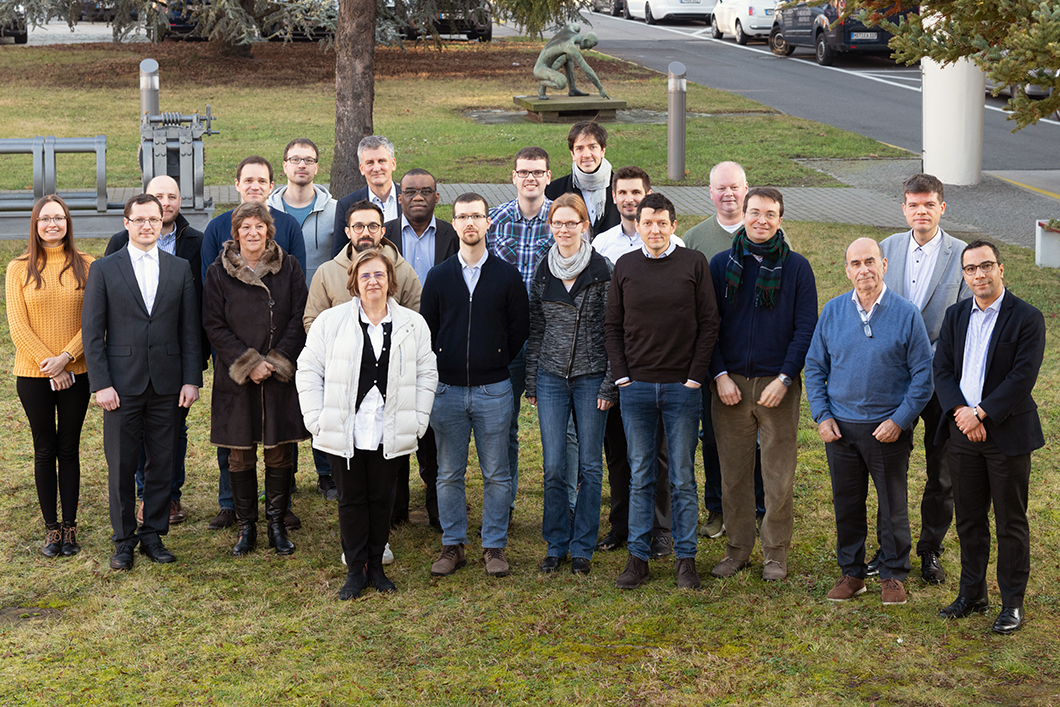
Offshore test installation of the ComoBelt for monitoring weld seams.
Source: Fraunhofer IKTS
Project period
01/01/2020 - 21/12/2023
Project type
EU project
Project status
Closed
Description
The GW4SHM project, funded by the Marie Skłodowska-Curie Actions Innovative Training Network (H2020-MSCA-ITN-2019-860104), aims at different aspects of Structural Health Monitoring (SHM) using guided ultrasonic waves and at training a new generation of researchers skilled in all aspects of Structural Health Monitoring focusing on aeronautics, petrochemistry and the automotive sector.
Location
Bundesanstalt für Materialforschung und -prüfung
Unter den Eichen 87
12205 Berlin
GW4SHM Logo Source: BAM
The European economy's adaptability to the challenges of digitisation and production automation will be crucial for its further success. Emerging technologies such as Condition Based Maintenance (CBM), integrated health monitoring including remaining lifetime prognosis and machine learning which are in the focus of the GW4SHM’s research activities will be a key enabler for successful transformation towards Industry 4.0. The three main contributions from GW4SHM to Europe's technological progress are: increase safety, increased reliability, saving resources and energy.
Source: BAM
The overall aim of GW4SHM is to turn SHM from a lab-based technology into real-world applications. To overcome current hurdles that prevent the widespread use of SHM, GW4SHM will pursue the following three objectives:
- create efficient simulation tools to predict ultrasonic wave propagation in real-life structures made of complex materials
- develop sophisticated signal processing algorithms to interpret the measured signals, assessing the damage, and eliminating environmental and operational influences in combination with advanced transducer integration
- devise strategies to assess the reliability of SHM methods with respect to their standardisation and to utilise SHM data for CBM and digital twins
The novel methods developed within GW4SHM will pave the way for integrating SHM into real-world engineering structures, thereby improving the safety and reliability of European plants, transport systems and critical infrastructure.
Source: BAM
New concepts for improved maintenance of technical appliances will be developed based on acquired SHM data, innovative models and signal processing tools. Finite Element Modelling will be performed to model wave propagation and their interaction with damage, to perform model-assisted Probability-of-Detection-studies (MAPOD) and to develop digital twins. It is possible due to a wide range of tools available within the Consortium. From a data analysis point of view, different signal processing tools are also available and will be further developed.
Source: BAM
The GW4SHM consortium consists of 12 beneficiaries and 8 partner organisations involving universities, research organisations, government agencies and industries from 8 European Countries. (see beneficiaries below)
Airbus - Airbus Defence and Space, Germany (Christoph Meisner)
Guided Ultrasonics Ltd., United Kingdom ( Dr Thomas Vogt)
DGZfP - German Society for Non-Destructive Testing, Germany Gunnar Morgenstern)
ISQ - Instituto de Soldadura e Qualidade, Portugal (Ana Maria Cabral)
Enefit - Enefit Energiatootmine AS, Estonia ( Jaanus Rattur)
Dallara - Dallara Automobili S.p.A., Italy (Dr Chiara Pernechele)
Shell - Shell Global Solutions International BV, Netherlands (Sieger Terpstra)
Ruhr Uni - Ruhr University Bochum, Germany
Delft University of Technology, Netherlands ( Prof. Nico de Jong, Prof. Rinze Benedictus)
University Duisburg-Essen (Prof. Carolin Birk)
The mission
The project will bring together partners from academia and industry and will train a new generation of researchers skilled in all aspects of SHM, enabling them to transform SHM research into practical applications. Focusing on aeronautics, petrochemistry and the automotive industry as initial pilot cases, we will develop SHM concepts to assess the integrity of structures and create ready-to-use tools for industry and other SHM users. The strong collaboration between mathematicians, physicists and engineers aims to bring the capabilities and applicability of SHM methods to the next level.
The training
Our Early Stage Researchers will acquire multidisciplinary scientific expertise, complementary skills, and experience for working in interdisciplinary teams. They will be in a prime position to take up leadership roles in academia and industry. They will enable Europe to take a leading role in the multidisciplinary area of making use of guided wave based SHM technology.
Technical work packages
The GW4SHM project consists of 3 technical work packages (WP) in addition to WPs on Training and Secondment, Dissemination and Communication as well as a work package on Recruitment and Management.
Simulation
Key goal is to extend the different numerical methods and combine them according to their pros and cons to profit from the advantages offered by a combination of the various approaches. The WP1 aims at the development of highly efficient, easy-to-use simulation tools and numerical models for the prediction of excitation, wave propagation, and mode-flaw interaction in realistic structures for use in research and industry.
Signal processing
This WP aims towards the adaption and optimisation of signal processing algorithms as well as transducer concepts for SHM applications. The focus is on interpreting ultrasonic signals, to extract information about damage type, location and size, to suppress the environmental and operational influences and to utilise information for subsequent maintenance processes in various real-life scenarios.
Reliability and Standardisation
Key goal is to extend Probability of Detection (POD) concepts mainly by applying highly efficient simulation tools towards a framework for demonstrating the performance and reliability of SHM systems as the foundation of qualification, certification and standardisation of SHM techniques.
Events
Kick-off and first training event
The kick-off meeting took place on 16th and 17th of January 2020 and saw the preparation of the Consortium Agreement, budget planning and recruitment of PhD students. It was followed by the first training event “Welcome Retreat” as an online meeting due to the pandemic.

GW4SHM Kick off at BAM in Berlin
Source: BAM
Second Training Session
The second training event was organised by the Bochum University of Applied Sciences (Hochschule Bochum). It was made up by three thematic areas: transferable skills, fundamentals on POD and guided wave simulation, as well as application notes from automotive and aerospace industries.
Transferable skills
Professional trainer Dr. Martina Michalikova (Writing Scientist) helped to develop writing competences of our ESRs within a Scientific Writing and Publishing Workshop held in three sessions - prior to, during and after the training event. This allowed the ESRs to process the material in between the sessions, ask questions during the following sessions, prepare abstracts for upcoming conferences and get professional feedback. In the “Talk to the editor”-Session the ESRs had the opportunity to talk to the managing editor of the most important journal in the field, the SHM Journal. Prof. Dr. Michael Todd (University of California) shared information on the publishing process.
Fundamentals
Model assisted quality assessment for guided wave-based systems has been the overarching topic of our fundamentals sessions. On the first day, Prof. Dr. Inka Mueller (Hochschule Bochum) and Dr. Kilian Tschöke (Fraunhofer IKTS) presented established techniques of quality assessment for methods used in Non-Destructive Testing and the ways to adopt these to SHM-Systems. The second day followed with fundamentals on the spectral Finite Element Method (FEM) by Dr. Alexandre Imperiale (CEA) and its validation with respect to SHM applications by Dr. Olivier Mesnil (CEA). On this basis, the ESRs got hands-on experience and deep insights in the special modelling software CIVA (Extende). Its SHM Module is based on the spectral FEM and allows to perform fast computations, which can also be used for quality assessment. Some of the ESRs have already managed to model examples which may be useful for their work. These examples, along with the overall progress of the individual research projects, were presented by the ESRs during the dedicated ESRs’ sessions.
Application notes
Different perspectives were given by the presenters with respect to aerospace and automotive applications. Project partners, Dr. Ronny Sachse and Dr. Chiara Pernechele gave overviews about SHM applications at Airbus Defence & Space and Dallara Automobili, respectively. An invited talk from Friedrich von Dungern (Invent) covered developments of piezoelectric transducers for aerospace and automotive applications and their integration into structures.
2022 IEEE International Ultrasonics Symposium
Early-Stage Career Researchers and Principal Investigators of the GW4SHM project present their work at IEEE International Ultrasonics Symposium, held on October 10-13, 2022, in Venice. Apart from oral and poster presentations, the GW4SHM project had its own booth, presenting a physical and virtual demonstration of different aspects of guided ultrasonic waves, including a snowflake-like transducers developed within the PhD project of Masoud Mohammadgholiha, an ESR working under the supervision of Prof. Dr. Luca De Marchi from University of Bologna.
Third Training Event (London)
During the five-day training the biggest names in this field, including Prof. Peter Cawley and Prof. Mike Lowe gave talks. Prof. Cawley's shared his experience in transforming lab-based research into real-world applications and gave insights into the challenges of industrializing and commercializing guided wave testing/monitoring technology were valuable. The event also provided a unique opportunity to see guided wave testing technology in action. Guided Ultrasonics Limited (GUL) is a world-leading company in the development and manufacturing of guided wave inspection and monitoring equipment. The tour gave us valuable insight into the practical applications of guided wave testing technology and inspired us to brainstorm new approaches to solving industry problems.
Fourth Training Event (Paris)
The training event in Paris was hosted by the French Atomic Energy Commission (CEA), one of the majors' agents in Non-Destructive Testing (NDT) and Structural Health Monitoring (SHM). Participants got to collaborate with another Innovative Training Network (ITN) group called ENHAnCE (European training Network in intelligent prognostics and Health mAnagement in Composite structurEs, Grant agreement ID: 859957) who share similar research topics related to SHM. Each day presentations by experienced researchers in NDT/SHM were held. The seminars were focused on guided waves modelling, fiber optics, additive manufacturing, innovative numerical methods, and artificial intelligence applied to NDT.
Participants also visited some of the laboratories at CEA, who carry out outstanding research in NDT/SHM, since they hold leading edge technology such as automated 3D scanners and a vast variety of electronic transducers and specimens, and the wide aircraft workshop of SAFRAN, who specialize in repair and maintenance of aircraft engines.
Fifth Training Event (Tallinn)
The fifth training event was hosted by Tallinn University of Technology, were the GW4SHM consortium had a deep insight into the theory and applications of SHM techniques based on guided waves, and also into the topics of investment and funding. Andi Hektor, founder of G-Scan technologies, gave a talk on the growing startup based in Estonia - pioneers in Atmospheric Ray Tomography, which is the new frontier of particle physics applications, with practical potential for customs, public safety, industrial, medical, and space-based applications.

Tallinn – Fifth Training Event - group picture of the GW4SHM project
Source: Aadhik Asokkumar
It was followed by a workshops on "How to create a Startup and Pitching". At the end of the week, the ESRs pitched their research topics in a competition in search of funding or investment. They also presented their work to their peers. Although all ESRs were working on guided wave-related projects, the research topics varied from guided wave imaging to machine learning applications.
Project coordination
BAM Bundesanstalt für Materialforschung und -prüfung (BAM), Germany
Project coordinator: Dr.-Ing. Jens Prager, Department Non-destructive Testing,
Division Acoustic and Electromagnetic Methods
Funding
This project has received funding from the European Union’s Horizon 2020 research and innovation programme under the Marie Skłodowska Curie grant agreement No [860104].
Beneficiaries
CEA-LIST - French Alternative Energies and Atomic Energy Commission (CEA-LIST), France (Dr Olivier Mesnil)
TNO - Netherlands Organisation for Applied Scientific Research (TNO), Netherlands (Dr Arno Volker)
IKTS - Fraunhofer Institute for Ceramic Technologies and Systems (IKTS), Germany (Dr Kilian Tschoeke)
Tallinn University - Tallinn University of Technology, Estonia (Dr Madis Ratassepp)
Hochschule Bochum - Bochum University of Applied Sciences, Germany ( Prof. Inka Mueller)
ICL - Imperial College London, United Kingdom (Dr Peter Huthwaite)
SAFRAN - Safran Tech., France ( Dr Rafik Hadjria)
Goethe Universität - Goethe University Frankfurt, Germany (Dr Jochen Moll)
KTU - Kaunas University of Technology, Lithuania (Prof. Renaldas Raisutis)
UNIBO - University of Bologna, Italy (Dr Luca De Marci)
IT - Institute of Telecommunication, Portugal (Prof. Helena Geirinhas Ramos)
Publications
2020-05-07, en.ktu.edu
KTU Professor Renaldas Rautis: pandemics come and go while science moves forwardiš
2020-06, www.ndt.net
Better monitoring of engineering structures will benefit industry and citizens alike
2020-05-25, dgzfp.de
EU-Projekt zu Structural Health Monitoring unter Beteiligung der DGZfP
2020-03-17, www.bindt.org
BAM leads new project on structural health monitoring of safety-relevant structures

Source: The European Union's Horizon 2020 research and innovation programme


